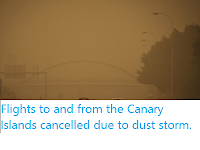Following a marked increase in seismic activity beneath La Palma volcano, on the Canary Island of the same name, authorities on the island began to make plans to evacuate residents from the area in the event of an eruption on 17 September 2021. Two days later, on Sunday 19 September, the volcano began to erupt at about 3.10 pm, with two fissures roughly 200 m long and 200 m apart opening on the flank of the volcano, producing columns of gas and ash that rose to 1.5 and 3.0 km above sealevel respectively, and lava fountains that set fire to nearby forests. Lava began to descend the sides of the volcano at a rate of about 700 m per hour (slow enough to evade at a walking pace), prompting evacuations and causing extensive damage to properties in its path. The volcano produced a vast plume of sulphur dioxide, which reached the coast of Morocco on 20 September, by which time lava flows had reached up to 3 km from the vents and destroyed 166 buildings. Over the next few days, the volcano produced further ash columns, which rose to heights as great as 4.6 km, while the lava spread to cover about 1.54 km², destroying over 350 homes and prompting the evacuation of over 5000 people.
The eruptions continued through the remainder of September, producing ash columns that rose up to 5 km above sealevel and lava flows that reached the west coast of the island at Playa de los Guirres, destroying over 650 buildings and 18.9 km of roads, and sulphur dioxide emissions of up to 25 000 tons per day.
On Friday 1 October 2021 a third vent was discovered to have opened on the side of the volcano, producing two new lava flows, one of which flowed rapidly towards the town of Los Llanos de Aridane, which has been partly evacuated in response. A total of over 6000 people have now been evacuated from their homes on the island, with over 7 km² covered by lava flows and over a thousand homes and other buildings destroyed.
The Canary Islands are a group of volcanic islands fuelled by a mantle plume rising through the African Plate, on which they are situated. The plume is rising from deep within the Earth, and is independent of the movement of the tectonic plates at the Earth's surface. As the plate moves relative to the hotspot new volcanic islands form on its surface, each over the hotspot when it forms, with the oldest islands of the chain in the east (the African Plate is being pushed east by the expansion of the Atlantic Ocean, but the hotspot is relatively motionless).
See also...



Follow Sciency Thoughts on Facebook.
Follow Sciency Thoughts on Twitter.






